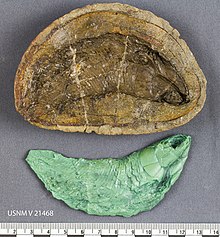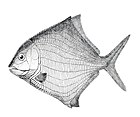| Boreosomus Temporal range:
| |
|---|---|

| |
| Boreosomus gillioti: fossil mold and latex cast | |
|
Scientific classification
| |
| Domain: | Eukaryota |
| Kingdom: | Animalia |
| Phylum: | Chordata |
| Class: | Actinopterygii |
| Order: | † Ptycholepiformes |
| Family: | † Ptycholepididae |
| Genus: | †
Boreosomus Stensiö, 1921 |
| Type species | |
| †Acrolepis arctica
Woodward, 1912
| |
| Synonyms | |
| |
Boreosomus (meaning: " boreal body") is an extinct genus of Triassic marine ray-finned fish. It was first described from the Arctic island of Spitsbergen ( Svalbard, Norway), hence its genus name, but was later also discovered in other parts of the world. The type species is Boreosomus arcticus (= Acrolepis arctica Woodward, 1912).
Classification


Boreosomus belongs to the family Ptycholepidae (= Boreosomidae/Chungkingichthyidae). Other genera of this family are Acrorhabdus ( Spitsbergen), Ardoreosomus ( Nevada, United States), Chungkingichthys ( China), Ptycholepis (global) and Yuchoulepis ( China). [1]
Some studies recover Boreosomus as a potential chondrostean. [2]
Description
A characteristic feature of Boreosomus and other ptycholepids is the dorsal fin, which inserts at the level of the pelvic fins in the middle portion of the body. Most contemporary ray-fins have their dorsal fin in a more posterior position, often opposite to the anal fin. Also typical for ptycholepids are the somewhat rectangular, horizontally arranged suborbital bones. [3]
Boreosomus gillioti could reach a body length of about 10–20 cm (3.9–7.9 in). Caudal fin was divided. Scales were strong and rectangular. [4]
Fossil record
Boreosomus had a worldwide distribution during the Early Triassic and is also known from the Middle Triassic. Fossils of Boreosomus were found, apart from Spitsbergen (Svalbard), in Greenland, Madagascar, China ( Shaanxi), Spain ( Catalonia), United States ( Arizona), and Canada ( British Columbia). [5] [6]
Species
- †Boreosomus arcticus ( Woodward, 1912) [ Acrolepis arctica Woodward 1912] ( type species) - Early Triassic ( Induan) of Svalbard
- †Boreosomus gillioti (Priem, 1924) [Diaphorognathus gillioti (Priem 1924); Gyrolepis gillioti Priem 1924] - Early Triassic (Induan) of Madagascar
- †Boreosomus piveteaui Nielsen, 1942 [3] - Earliest Triassic (Induan) of Greenland
- †Boreosomus reuterskioeldi Stensiö, 1921 - Early Triassic (Induan) of Svalbard
- †Boreosomus scaber Stensiö, 1921 - Early Triassic ( Spathian) of Svalbard
Indeterminate species are known from the Early Triassic of Canada (British Columbia) and China ( Guizhou), as well as the Middle Triassic of Svalbard, Spain, and possibly the United States (Arizona). [5]
The species B. merlei is now placed in Australosomus. [7]
See also
References
- ^ Romano, Carlo; López-Arbarello, Adriana; Ware, David; Jenks, James F.; Brinkmann, Winand (2019). "Marine Early Triassic Actinopterygii from the Candelaria Hills (Esmeralda County, Nevada, USA)". Journal of Paleontology. 93 (5): 971–1000. Bibcode: 2019JPal...93..971R. doi: 10.1017/jpa.2019.18. S2CID 155564297.
- ^ Near, Thomas J; Thacker, Christine E (18 April 2024). "Phylogenetic classification of living and fossil ray-finned fishes (Actinopterygii)". Bulletin of the Peabody Museum of Natural History. 65. doi: 10.3374/014.065.0101.
- ^ a b Nielsen, Eigil (1942). "Studies on Triassic fishes from East Greenland 1. Glaucolepis and Boreosomus". Palaeozoologica Groenlandica. 1: 1–403.
- ^ The Fossil Forum
- ^ a b "PBDB". paleobiodb.org. Retrieved 2024-04-01.
- ^ Romano, Carlo; Koot, Martha B.; Kogan, Ilja; Brayard, Arnaud; Minikh, Alla V.; Brinkmann, Winand; Bucher, Hugo; Kriwet, Jürgen (2016). "Permian-Triassic Osteichthyes (bony fishes): diversity dynamics and body size evolution". Biological Reviews. 91 (1): 106–147. doi: 10.1111/brv.12161. PMID 25431138. S2CID 5332637.
- ^ Brinkmann, W.; Romano, C.; Bucher, H.; Ware, D.; Jenks, J. (2010). "Palaeobiogeography and stratigraphy of advanced Gnathostomian fishes (Chondrichthyes and Osteichthyes) in the Early Triassic and from selected Anisian localities (report 1863-2009): Literaturbericht". Zentralblatt für Geologie und Paläontologie, Teil II. 2009 (5/6): 765–812. doi: 10.5167/uzh-34071. ISSN 0044-4189.
- Prehistoric ray-finned fish genera
- Early Triassic fish
- Middle Triassic fish
- Triassic bony fish
- Fossils of Svalbard
- Fossils of Greenland
- Fossils of Madagascar
- Fossils of China
- Fossils of British Columbia
- Triassic fish of North America
- Triassic fish of Europe
- Triassic fish of Asia
- Triassic fish of Africa
- Induan genus first appearances
- Olenekian genera
- Anisian genera
- Ladinian genus extinctions
- Prehistoric ray-finned fish stubs
- Triassic fish stubs
- Fossil taxa described in 1921
| Boreosomus Temporal range:
| |
|---|---|

| |
| Boreosomus gillioti: fossil mold and latex cast | |
|
Scientific classification
| |
| Domain: | Eukaryota |
| Kingdom: | Animalia |
| Phylum: | Chordata |
| Class: | Actinopterygii |
| Order: | † Ptycholepiformes |
| Family: | † Ptycholepididae |
| Genus: | †
Boreosomus Stensiö, 1921 |
| Type species | |
| †Acrolepis arctica
Woodward, 1912
| |
| Synonyms | |
| |
Boreosomus (meaning: " boreal body") is an extinct genus of Triassic marine ray-finned fish. It was first described from the Arctic island of Spitsbergen ( Svalbard, Norway), hence its genus name, but was later also discovered in other parts of the world. The type species is Boreosomus arcticus (= Acrolepis arctica Woodward, 1912).
Classification


Boreosomus belongs to the family Ptycholepidae (= Boreosomidae/Chungkingichthyidae). Other genera of this family are Acrorhabdus ( Spitsbergen), Ardoreosomus ( Nevada, United States), Chungkingichthys ( China), Ptycholepis (global) and Yuchoulepis ( China). [1]
Some studies recover Boreosomus as a potential chondrostean. [2]
Description
A characteristic feature of Boreosomus and other ptycholepids is the dorsal fin, which inserts at the level of the pelvic fins in the middle portion of the body. Most contemporary ray-fins have their dorsal fin in a more posterior position, often opposite to the anal fin. Also typical for ptycholepids are the somewhat rectangular, horizontally arranged suborbital bones. [3]
Boreosomus gillioti could reach a body length of about 10–20 cm (3.9–7.9 in). Caudal fin was divided. Scales were strong and rectangular. [4]
Fossil record
Boreosomus had a worldwide distribution during the Early Triassic and is also known from the Middle Triassic. Fossils of Boreosomus were found, apart from Spitsbergen (Svalbard), in Greenland, Madagascar, China ( Shaanxi), Spain ( Catalonia), United States ( Arizona), and Canada ( British Columbia). [5] [6]
Species
- †Boreosomus arcticus ( Woodward, 1912) [ Acrolepis arctica Woodward 1912] ( type species) - Early Triassic ( Induan) of Svalbard
- †Boreosomus gillioti (Priem, 1924) [Diaphorognathus gillioti (Priem 1924); Gyrolepis gillioti Priem 1924] - Early Triassic (Induan) of Madagascar
- †Boreosomus piveteaui Nielsen, 1942 [3] - Earliest Triassic (Induan) of Greenland
- †Boreosomus reuterskioeldi Stensiö, 1921 - Early Triassic (Induan) of Svalbard
- †Boreosomus scaber Stensiö, 1921 - Early Triassic ( Spathian) of Svalbard
Indeterminate species are known from the Early Triassic of Canada (British Columbia) and China ( Guizhou), as well as the Middle Triassic of Svalbard, Spain, and possibly the United States (Arizona). [5]
The species B. merlei is now placed in Australosomus. [7]
See also
References
- ^ Romano, Carlo; López-Arbarello, Adriana; Ware, David; Jenks, James F.; Brinkmann, Winand (2019). "Marine Early Triassic Actinopterygii from the Candelaria Hills (Esmeralda County, Nevada, USA)". Journal of Paleontology. 93 (5): 971–1000. Bibcode: 2019JPal...93..971R. doi: 10.1017/jpa.2019.18. S2CID 155564297.
- ^ Near, Thomas J; Thacker, Christine E (18 April 2024). "Phylogenetic classification of living and fossil ray-finned fishes (Actinopterygii)". Bulletin of the Peabody Museum of Natural History. 65. doi: 10.3374/014.065.0101.
- ^ a b Nielsen, Eigil (1942). "Studies on Triassic fishes from East Greenland 1. Glaucolepis and Boreosomus". Palaeozoologica Groenlandica. 1: 1–403.
- ^ The Fossil Forum
- ^ a b "PBDB". paleobiodb.org. Retrieved 2024-04-01.
- ^ Romano, Carlo; Koot, Martha B.; Kogan, Ilja; Brayard, Arnaud; Minikh, Alla V.; Brinkmann, Winand; Bucher, Hugo; Kriwet, Jürgen (2016). "Permian-Triassic Osteichthyes (bony fishes): diversity dynamics and body size evolution". Biological Reviews. 91 (1): 106–147. doi: 10.1111/brv.12161. PMID 25431138. S2CID 5332637.
- ^ Brinkmann, W.; Romano, C.; Bucher, H.; Ware, D.; Jenks, J. (2010). "Palaeobiogeography and stratigraphy of advanced Gnathostomian fishes (Chondrichthyes and Osteichthyes) in the Early Triassic and from selected Anisian localities (report 1863-2009): Literaturbericht". Zentralblatt für Geologie und Paläontologie, Teil II. 2009 (5/6): 765–812. doi: 10.5167/uzh-34071. ISSN 0044-4189.
- Prehistoric ray-finned fish genera
- Early Triassic fish
- Middle Triassic fish
- Triassic bony fish
- Fossils of Svalbard
- Fossils of Greenland
- Fossils of Madagascar
- Fossils of China
- Fossils of British Columbia
- Triassic fish of North America
- Triassic fish of Europe
- Triassic fish of Asia
- Triassic fish of Africa
- Induan genus first appearances
- Olenekian genera
- Anisian genera
- Ladinian genus extinctions
- Prehistoric ray-finned fish stubs
- Triassic fish stubs
- Fossil taxa described in 1921







